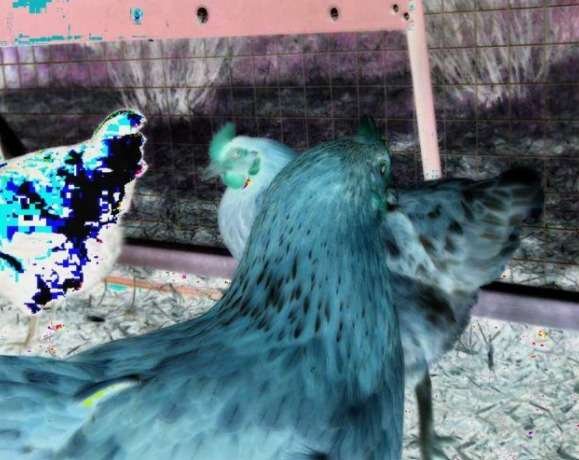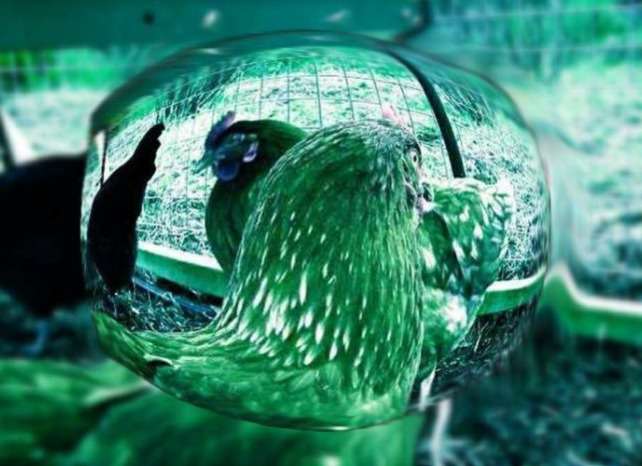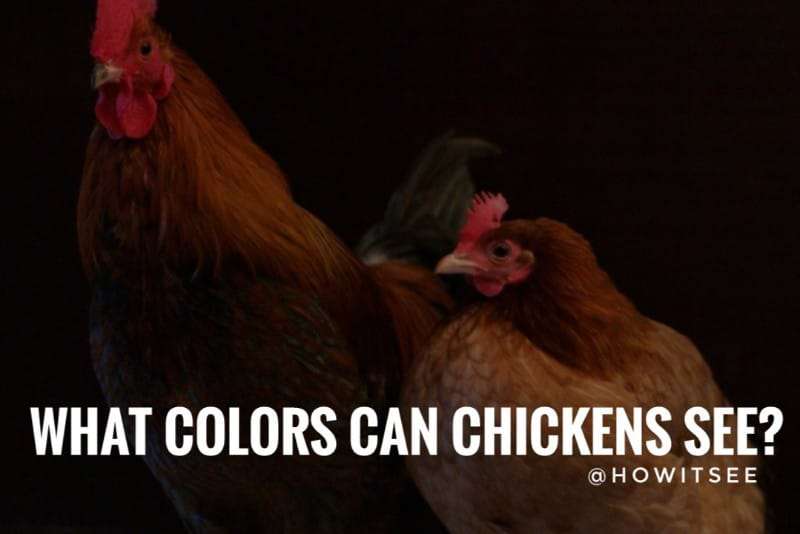Chickens are domesticated birds with a total population of more than 23.7 billion globally. The number is far greater than any other bird species. The adult male birds are called roosters, and the term hen is used for adult female birds.
We all have seen chicken at least once in our life. So, have you been fascinated by “what colors can chickens see” or “are chickens color blind“? If yes, then below is the answer.
Chickens can see more color shades than humans. They are not colorblind and have five types of different cones in their eyes. These cones can perceive red, green, blue, violet, and ultraviolet light. It allows them to sense and differentiate far more hues than humans can.
The additional ultraviolet sensing cone in chickens’ eyes serve them to carry out daily activities like mate selection, chick health identification, differentiating eggs, and finding safe foods.
Chickens have much more advanced vision than humans in terms of color recognition. Later in this post, we have explained much about chickens’ vision and answered many relevant queries to clear every doubt. So, let’s begin.
What colors do Chickens see?
Chickens are tetrachromats means the cones in their eyes are sensitive to red, green, blue, violet, and ultraviolet light. On the contrary, humans are trichromats and can sense only red, green, and blue color shades.
Chickens can sense a wide range of electromagnetic spectrums compared to humans. They can recognize all shades of blue and violet hues with ultraviolet light that helps them to find shiny bugs, seeds, ripened fruits, berries, etc.
According to the research, chickens have five types of light receptors in the eyes. These receptors assist them in maximizing their ability to distinguish various color variations.

They have one additional cone in their eyes for motion-detecting. It enables them to sense the slightest of movements in the environment.
Example: creeping of bugs and insects through the grass. Many researchers have noticed that chickens can perceive the wavelength from 300 nm to 700 nm (approximately).
Like other birds, chickens can also absorb blue, green, and red colors best at 445, 508, and 565 nm, which is different than humans, that perceive wavelengths best at 424, 530, and 560 nm.
In this way, you can estimate that chickens can sense the shades of a particular hue in a much more diverse way.
In a nutshell, chickens have excellent color vision and can sense the colors that are invisible to us. The ability to perceive ultraviolet light assists them in many ways.
- 1) Chicken health-
Hens can identify their chicks’ health by sensing ultraviolet fluorescence reflecting from their feathers. They can recognize which chicks are stronger or weaker and devote more energy to taking care of them.
- 2) Male selection-
Male chickens exhibit vibrant and fluorescent colors from their feathers to display their physical fitness invisible to the human eye. Hens select only potential mates for breeding based on these fluorescent colors.
- 3) Identification-
Chickens identify different breeds or other chickens through the ultraviolet colors emitting from their feathers. Their vision to sense U.V. light assists them in recognizing other breeds.
- 4) Finding food-
To find and discern different shinning beetles, insects, spiders, grains, plants, and other food items, chickens use their ultraviolet vision.
Are Chickens colorblind?
Chickens are not colorblind. They can see even more hues than humans. Chickens can distinguish more spectrums of color with different peak sensitivity. It enables them the ability to see the environment with more colors.
Chickens’ eyesight is more sensitive to violet-blue, whereas human vision tends to be orange-red. Hence, they form the images in more violet-blue colors with ultraviolet light. Below is the image of what colors chickens see.

Credits | The Poultry Pages Backgarden Chickens & Other Poultry by Chickens Allotment Garden
As the image demonstrates, chickens can sense more fluorescent hues.
About Chicken’s Eye-
- Chickens’ eyes comprise 10 percent of the entire mass of their head, which is far greater than human eyes. It implies that they are predominately dependent on their eyes to survive.
- They have eyes on the sides of the heads that grant them 300 degrees of field of vision.
- Chickens have monocular vision. It means that they have a wide range of fields of view. On the other hand, humans have binocular vision means we have a great depth of view rather than a wide range.
- Similar to upper and lower eyelids, they have a third transparent eyelid called a nictating eyelid that prevents dust, dirt, and other debris from entering the eyes.
Can Chickens see in the dark?
Chickens cannot see well in the dark. They are diurnal birds means they have more cones than rods in their eyes, which allows them to see best in the daylight.
Unlike other nocturnal birds, they do not have tapetum lucidum, a thin reflective membrane in their eyes. And in the presence of only fewer rods, they cannot visually discern the surroundings at night.
In the eyes, rods are responsible for sensing the brightness/amount of light, whereas cones are sensitive toward colors. Hence, due to the lack of a large number of rods in the eyes, chickens cannot see in the dark.
At night when the light level drops below their threshold level, they become extremely sensitive and easy prey for many predators. That is why at that time, it is the responsibility of the chicken owners to safely puts them in their roosting area.
How do Chickens see humans?
Chickens can see humans the same as we do. They can recognize up to a hundred faces and easily recognize their owners or caretakers. Also, they remember the positive and negative experiences with a particular face they recognize and can communicate their experience to flocks.

Many chicken owners have claimed that chickens can also show their emotions to humans. They make several types of sounds while communicating with us. Also, hens make certain sounds to call other hens or their babies.
How do Chickens see the world?
Chickens are near-sighted and see the world in detail, like humans. Like many birds, they have monocular vision and cannot focus far distant entities.

Credits | The Poultry Pages Backgarden Chickens & Other Poultry by Chickens Allotment Garden
Also, their eyesight is predominately focused on violet and blue color shades with a mixture of ultraviolet light. Hence, they see the world more in blue shades, whereas humans see the world more in red-orange shades.
Interesting Fact- Since birth, chickens’ right eye has been near-sighted, which helps them to find food, and their left eye is far-sighted, which identifies predators.
Why are red color bulbs so important for Chickens?
Red color lamp bulbs prevent aggression and pecking issues among baby chicks. According to the research, it is noticed that chicks are aggressive towards the blood or pinkish skin. That is why they start attacking injured chicks.
Using a red heat lamp makes the environment red, and chicks cannot discriminate blood in the red surrounding. This is the reason why many researchers recommend using red heat lamps.
Also, chickens are more attracted to the red color. Therefore, many chicken owners paint feeders and waterers in red color.
Chicken vision vs. Human vision
| Chicken Vision | Human Vision |
| Have monocular vision | Have binocular vision |
| Are tetrachromats (can see red, green, blue and ultraviolet light) | Are trichromats (can see only red, green, and blue) |
| Cannot perceive in the dark | Cannot perceive in the dark |
In conclusion, chickens have a unique and fascinating visual system that allows them to see a wider range of colors than humans.
They are particularly sensitive to light in the blue and green parts of the spectrum, and their ability to perceive these colors is important for their navigation, foraging, and social behaviors.
While chickens may not see the world in the same way that we do, their vision is finely tuned to meet their specific needs as a species.
Understanding how chickens see can provide valuable insights for those working with poultry and can help to improve their welfare and living conditions.
We hope you like this post. We will be back with another article. Till then, stay tuned with us and read the FAQ section below.
Frequently Asked Questions-
Q1. Do chickens have good eyesight?
Ans. Yes, like other birds, chickens also have good eyesight.
Q2. How far can a chicken see?
Ans. Chickens can see very far but can not focus in detail, same as humans.
References
- Image Source- The Poultry Pages Backgarden Chickens & Other Poultry by Chickens Allotment Garden
- Chickens See Color Better Than Humans by Live Science
Also Read:

Meet Abhidept (nickname Monty), the visionary founder of How It See, being an engineering student, he’s fueled by an insatiable curiosity about the world around him. He is captivated by an eclectic correlation between animal groups, science, and nature, and this fascination drives his quest for understanding.
After completing his degree, he’s set on a mission to delve deep into the realm of nature, accumulating knowledge to share with you through his writing. In the meantime, he loves to watch anime and read anime.
